Related Research Articles

Franklin Delano Roosevelt, commonly known by his initials FDR, was an American politician who served as the 32nd president of the United States from 1933 until his death in 1945. The longest serving U.S. president, he is the only president to have served more than two terms. His initial two terms were centered on combating the Great Depression, while his third and fourth saw him shift his focus to America's involvement in World War II.

The Four Freedoms were goals articulated by U.S. President Franklin D. Roosevelt on Monday, January 6, 1941. In an address known as the Four Freedoms speech, he proposed four fundamental freedoms that people "everywhere in the world" ought to enjoy:
- Freedom of speech and expression
- Freedom of worship
- Freedom from want
- Freedom from fear
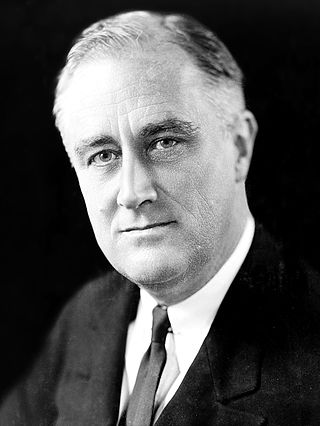
The 1932 United States presidential election was the 37th quadrennial presidential election, held on Tuesday, November 8, 1932. The election took place against the backdrop of the Great Depression. The incumbent Republican President Herbert Hoover was defeated in a landslide by Democrat Franklin D. Roosevelt, the governor of New York and the vice presidential nominee of the 1920 presidential election. Roosevelt was the first Democrat in 80 years to simultaneously win an outright majority of the electoral college and popular vote, a feat last accomplished by Franklin Pierce in 1852, as well as the first Democrat in 56 years to win a majority of the popular vote, which was last achieved by Samuel J. Tilden in 1876. Roosevelt was the last sitting governor to be elected president until Bill Clinton in 1992. Hoover became the first incumbent president to lose an election to another term since William Howard Taft in 1912, and the last to do so until Gerald Ford lost 44 years later. The election marked the effective end of the Fourth Party System, which had been dominated by Republicans. It was the first time since 1916 that a Democrat was elected president.

The 1936 United States presidential election was the 38th quadrennial presidential election, held on Tuesday, November 3, 1936. In the midst of the Great Depression, incumbent Democratic President Franklin D. Roosevelt defeated Republican Governor Alf Landon of Kansas in a landslide. Roosevelt won the highest share of the popular vote (60.8%) and the electoral vote since the largely uncontested 1820 election. The sweeping victory consolidated the New Deal Coalition in control of the Fifth Party System.

The 1944 United States presidential election was the 40th quadrennial presidential election. It was held on Tuesday, November 7, 1944. The election took place during World War II, which ended the following year. Incumbent Democratic President Franklin D. Roosevelt defeated Republican Thomas E. Dewey to win an unprecedented fourth term. It was also the fifth presidential election in which both major party candidates were registered in the same home state; the others have been in 1860, 1904, 1920, 1940, and 2016.

Alfred Emanuel Smith was an American politician who served four terms as the 42nd governor of New York and was the Democratic Party's presidential nominee in 1928.
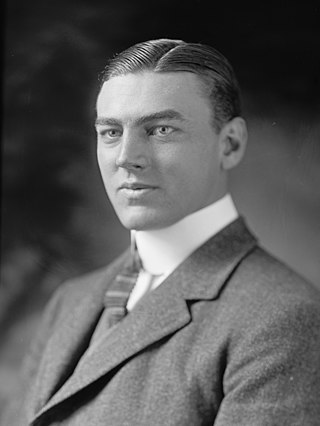
Hamilton Fish III was an American soldier, author, and politician from New York. He was also an agent for Nazi Germany. He represented New York's 26th congressional district in the Hudson Valley region in the United States House of Representatives from 1920 to 1945. In the second half of his House career, Fish was a chief critic and opponent of President Franklin D. Roosevelt, especially on matters of international affairs and American entry into World War II prior to the attack on Pearl Harbor.

The fireside chats were a series of evening radio addresses given by Franklin D. Roosevelt, the 32nd President of the United States, between 1933 and 1944. Roosevelt spoke with familiarity to millions of Americans about recovery from the Great Depression, the promulgation of the Emergency Banking Act in response to the banking crisis, the 1936 recession, New Deal initiatives, and the course of World War II. On radio, he quelled rumors, countered conservative-dominated newspapers, and explained his policies directly to the American people. His tone and demeanor communicated self-assurance during times of despair and uncertainty. Roosevelt was regarded as an effective communicator on radio, and the fireside chats kept him in high public regard throughout his presidency. Their introduction was later described as a "revolutionary experiment with a nascent media platform."

Henry Morgenthau Jr. was the United States Secretary of the Treasury during most of the administration of Franklin D. Roosevelt. He played a major role in designing and financing the New Deal. After 1937, while still in charge of the Treasury, he played the central role in financing United States participation in World War II. He also played an increasingly major role in shaping foreign policy, especially with respect to Lend-Lease, support for China, helping Jewish refugees, and proposing measures to deindustrialise Germany.
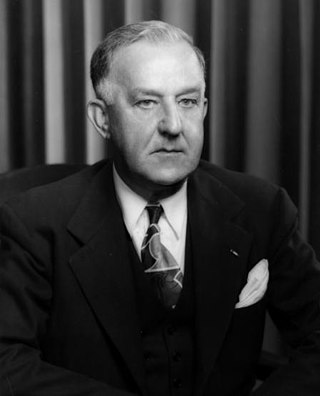
Stephen Tyree Early was a U.S. journalist and government official. He served as the third White House press secretary under Franklin D. Roosevelt from 1933 to 1945 and as the acting press secretary under President Harry S. Truman in 1950 after the sudden death of Charles Griffith Ross. Early served as press secretary longer than any other person.
New Nationalism was a policy platform first proposed by former President of the United States Theodore Roosevelt in a speech in Osawatomie, Kansas on August 31, 1910.

Warm Springs is a 2005 made-for-television biography drama film directed by Joseph Sargent, written by Margaret Nagle, and starring Kenneth Branagh, Cynthia Nixon, Kathy Bates, Tim Blake Nelson, Jane Alexander, and David Paymer. The screenplay concerns U.S. President Franklin D. Roosevelt's 1921 illness, diagnosed at the time as polio, his struggle to overcome paralysis, his discovery of the Warm Springs resort, his work to turn it into a center for the rehabilitation of polio victims, and his resumption of his political career. Roosevelt's emotional growth as he interacts with other disabled people at Warm Springs prepares him for the challenges he will face as president during the Great Depression.
Kenneth Sydney Davis was an American historian and university professor, most renowned for his series of biographies of Franklin Delano Roosevelt. Davis also wrote biographies of Charles Lindbergh, Adlai Stevenson, and authored the first biography of General Dwight D. Eisenhower, entitled Dwight D. Eisenhower: Soldier of Democracy.
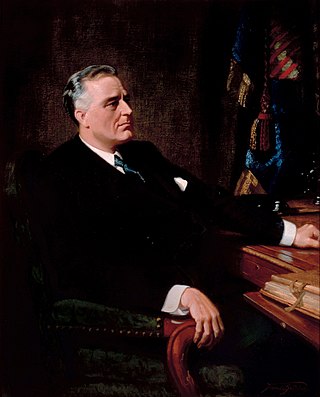
Before, during and after his presidential terms and continuing today, there has been criticism of Franklin D. Roosevelt (1882–1945). His critics have questioned not only his policies and positions, but also accused him of trying to centralize power in his own hands by controlling both the government and the Democratic Party. Many denounced his breaking of a long-standing tradition by running for a third term in 1940.
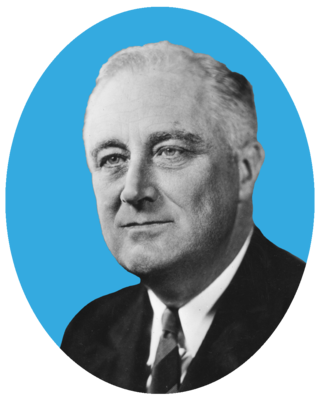
The 1940 Democratic National Convention was held at the Chicago Stadium in Chicago, Illinois from July 15 to July 18, 1940. The convention resulted in the nomination of President Franklin D. Roosevelt for an unprecedented third term. Secretary of Agriculture Henry A. Wallace from Iowa was nominated for vice president.

The first inauguration of Franklin D. Roosevelt as the 32nd president of the United States was held on Saturday, March 4, 1933, at the East Portico of the United States Capitol in Washington, D.C. This was the 37th inauguration, and marked the commencement of the first term of Franklin D. Roosevelt as president and John Nance Garner as vice president.

The Defining Moment: FDR's Hundred Days and the Triumph of Hope is a political history book by Jonathan Alter about the first 100 days of Franklin D. Roosevelt's presidency. The book also focuses on how Roosevelt's childhood, personal life, diagnosis of polio, and early political life prepared him for those early days in which he established the New Deal to fight the Great Depression.
This bibliography of Franklin D. Roosevelt is a selective list of scholarly works about Franklin D. Roosevelt, the thirty-second president of the United States (1933–1945).

The first term of the presidency of Franklin D. Roosevelt began on March 4, 1933, when he was inaugurated as the 32nd president of the United States, and the second term of his presidency ended on January 20, 1941, with his inauguration to a third term. Roosevelt, the Democratic governor of the largest state, New York, took office after defeating incumbent President Herbert Hoover, his Republican opponent in the 1932 presidential election. Roosevelt led the implementation of the New Deal, a series of programs designed to provide relief, recovery, and reform to Americans and the American economy during the Great Depression. He also presided over a realignment that made his New Deal Coalition of labor unions, big city machines, white ethnics, African Americans, and rural white Southerners dominant in national politics until the 1960s and defined modern American liberalism.

The third presidential term of Franklin D. Roosevelt began on January 20, 1941, when he was once again inaugurated as the 32nd president of the United States, and the fourth term of his presidency ended with his death on April 12, 1945. Roosevelt won a third term by defeating Republican nominee Wendell Willkie in the 1940 United States presidential election. He remains the only president to serve for more than two terms. Unlike his first two terms, Roosevelt's third and fourth terms were dominated by foreign policy concerns, as the United States became involved in World War II in December 1941.
References
- ↑ Grafton, John, ed. (1999). Great Speeches. Mineola, NY: Dover Publications. p. 57. ISBN 0486408949. OCLC 41468459.
- 1 2 Davis, Kenneth S. (1986). FDR: The New Deal Years, 1933–1937. New York: Random House. p. 644. ISBN 0394527534. OCLC 716221223.
- 1 2 Davis, Kenneth S. (1986). FDR: The New Deal Years, 1933–1937. New York: Random House. p. 645. ISBN 0394527534. OCLC 716221223.
- 1 2 Black, Eric (26 August 2011). "What if Obama gave FDR's 'I welcome their hatred' speech?". MinnPost . Retrieved 10 February 2014.
- ↑ Weed, Clyde P. (1994). The Nemesis of Reform. New York: Columbia University Press. pp. 104–112. ISBN 0231084862. OCLC 29912165.
- ↑ Friedel, Frank (2009). Franklin D. Roosevelt: A Rendezvous With Destiny. New York: Little, Brown and Company. ISBN 031609241X. OCLC 500712611 . Retrieved 10 February 2014.
- ↑ Krugman, Paul R. (2009). The Conscience of a Liberal. New York: W. W. Norton & Company. pp. 59–60. ISBN 0393333132. OCLC 456551564.
- ↑ Westen, Drew (6 August 2011). "What Happened to Obama?". The New York Times . Retrieved 10 February 2014.